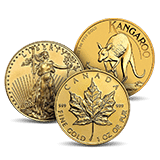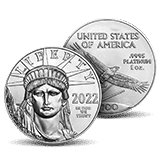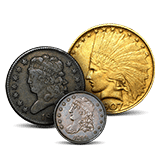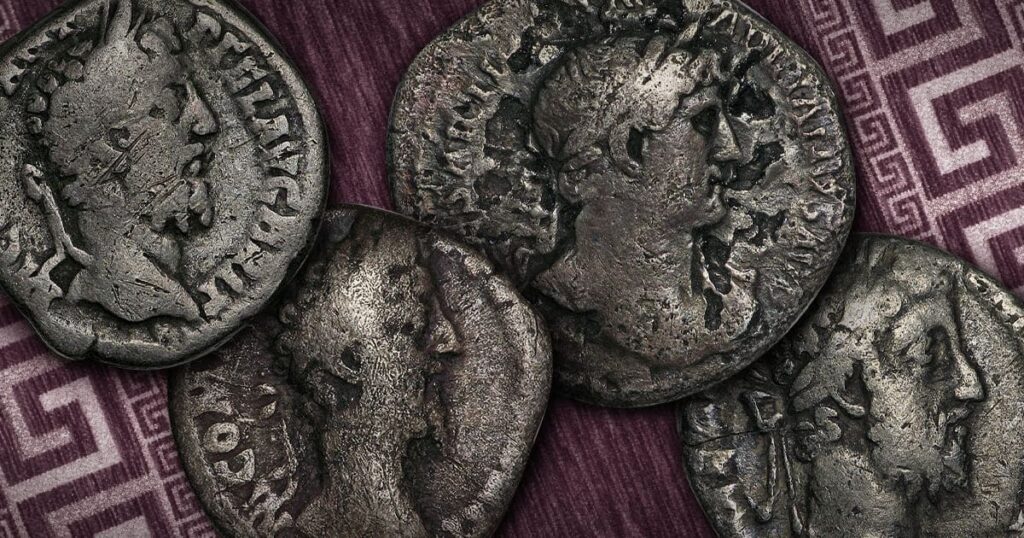
The Power of Coins
Most people have only seen Roman coins in museums or in movies. They have a difficult time believing they could own a very old and historic coin or actually build a real collection of different Roman Emperors.
Although coins were an integral part of ancient societies – especially in Mesopotamia and in Ancient Greece – Ancient Roman coins were a later entry, though these coins date as far back as the 4th century B.C. when Rome was still considered a Republic. During the time of the Roman Republic, Rome expanded its control over the known Mediterranean world. This period of political and geographical expansion for Rome resulted in very interesting coins minted as a symbol of status, power, and subjugation. Coins were often used during ancient times to cement higher positions of power as Emperors wished to be depicted with a god-like status – one of the first being Julius Caesar. Coins were also struck to commemorate festivals, appease the gods, or celebrate important events such as a victory in battle over an opponent.
Julius Caesar was the first Roman to order that coins be struck featuring his portrait, starting a trend that many Roman Emperors after him would follow. The Emperor would financially benefit from coins bearing his likeness and struck in his honor, as numerous examples would be given to him. This led to generations of wealth and growth he could never have imagined when commissioning the first Roman coins.
Different Types of Roman Coins
The Romans used a variety of coins, sizes, and metals for their currency. The least valuable coin, but one of the most struck coins, was the Aes, similar to our one-cent piece. It was struck in bronze and later in copper, and as its buying power decreased, the size of the coin generally decreased.
The Dupondius was worth twice what an Aes coin was worth and had twice the buying power. The Sestertius was a larger brass coin worth 4 times the value of an Aes. A Follis is a larger bronze coin made with a small amount of silver included. Its value varied, but it was generally greater than a Sestertius.
The Roman Denarius was the standard silver coin of the Roman Empire. It was worth approximately 16 Aes – sometimes less and sometimes more. The Antoninianus was worth two Denarii, or approximately 32 Aes.
Finally, the gold coin of the Romans was the Aureus, which was equal to 25 Denarii or 400 Aes. This coin was changed in size and weight depending on the economic situation of the times. It was replaced by the Solidus, which was struck for seven centuries by the Byzantines, even after the fall of the Roman Empire.
The Denarius: Rome’s Main Currency
Roman coins had significant intrinsic value not always equivalent to their Precious Metal content. For example, researched estimates show the denarius value ranged from 1.6 to 2.85 times its metal content – making it a significant coin in Ancient Rome. That is because there was no standard for the value of precious metals at that time.
The Silver denarius was the most important coin in Ancient Rome for almost 500 years and was introduced into circulation as early as 211 B.C. This coin was made with high purity Silver and weighed about 4.5 grams, which made it a little larger than the current United States dime. The denarius was created to pay mercenaries in the Roman armies for their services, as opposed to being paid in the traditional Roman bronze coins of the time. It was the most desired and practical of all Roman coins during its day.
One of the reasons for the success of the Roman denarius was its perceived value. Even though this coin was made of silver and a 5% alloy, it was in demand. As the economics changed, the amount of the alloy increased from 5% to up to 50%, and it was still very much in demand; this perceived value compensated for the actual metal value of the coin itself. Ancient Romans started to price their goods and services denominated in denarii. The denarius remained popular until disappeared from circulation around 238-244 A.D.
Reading Ancient Coins
One of the great things about Roman coins is that, unlike modern coins, they provide a fascinating insight into the history of Ancient Rome. Each Roman coin tells its own story, and with a little research, you can begin to piece together these stories and better understand Rome. Here are some tips for reading Roman coins:
- Start by looking at the obverse of the coin. The obverse usually features the image of the current Emperor or, in earlier coins, Ancient Roman gods. This can provide an indication of when the coin was minted. The Emperor’s name is usually abbreviated and displayed in letters around the periphery of the coin.
- Then, look at the coin’s reverse. The reverse often features Ancient Roman allegorical symbols such as Victory, a God, an eagle, or a wreath. These can also help to date the coin. The coins were also struck to commemorate popular religious festivals or, more importantly, victorious armies in battle. Those elements tell an important story and help date the coin by the date of the event and by the Emperor portrayed on the obverse.
- Finally, consult a reference book such as “Roman Imperial Coins” by Spink or a website such as Online Coins of the Roman Empire (https://numismatics.org/ocre/) to help identify the coin and learn more about its history.
Roman coins offer a great glimpse into the culture, society, and day-to-day lives of one of the most fascinating empires in history. The different types of Roman coins each have their own story to tell, making them a highly collectible item for coin enthusiasts and history buffs alike.
Roman Coins – A Brief History
Roman coins have a long and fascinating history. The first Roman coins were created around 269 B.C. during the Roman Republic. These early coins were made of Bronze and Copper and featured images of animals and mythological creatures.
By around 211 B.C., the Romans had switched to Silver for their coins when the denarius became the standard currency. Roman coins continued to be made of Silver until the late 3rd century A.D. After the fall of the Western Roman Empire in 476 A.D., Roman coins continued to be minted in the Eastern Byzantine Empire until around 1453 A.D. These later Roman coins were made of Gold, Silver, and Bronze and featured the image of the Byzantine Emperor on the obverse.
Roman Republic vs Roman Empire
One of the most common questions about Roman coins is: what is the difference between the Roman Republic and the Roman Empire?
The simple answer is that the Roman Republic (existing from around 500 B.C. to 27 B.C.) was a time of great political turmoil in Rome, while the Roman Empire (existing from 27 B.C. to 476 A.D.) was a period of stability and prosperity. During this period, the extent of Rome’s might was felt throughout much of the known world at that time.
However, some more nuanced differences exist between Roman coins minted during the Republic and those minted during the Empire. For example, Roman coins minted during the Republic tend to be smaller and less ornate than those minted during the Empire.
Roman coins from the Republic are generally less common and more valuable than those from the Empire. This is because fewer Roman coins were minted during the Republic, and many of these coins have been lost or damaged over time.
Roman Coins Over Time: Debasement and Value
Roman coins were debased over time, meaning that the quality and purity of the metal decreased. This was done for various reasons, such as to reduce costs or increase the monetary supply. This debasement resulted in Roman coins from later periods being generally worth less than those from earlier periods. This is because the metal in later coins is not as pure and thus not as valuable. However true that may be, the value of Roman coins is based on supply, demand, and condition rather than the bullion value.
When collecting Roman coins, you may account for the era in which the coin was minted. Roman coins from earlier periods are usually more valuable than those from later periods. However, there are exceptions to this rule – for example, some Bronze coins from the 3rd century A.D. are more valuable than Silver coins from the same period.
The Emperor portrayed on the coin is extremely important to the coin’s value. Everyone has heard of Julius Caesar, and any coin issued during his reign, especially those with his portrait on them, are always in demand and valuable. Coins of Nero or Cleopatra, or Marc Antony are all highly desirable as opposed to other much less well-known emperors.
The condition of the coin impacts value as well. Roman coins that are in excellent condition are more valuable than those that are in worn condition. This is because well-preserved Roman coins are much rarer than those that have been damaged or worn over time.
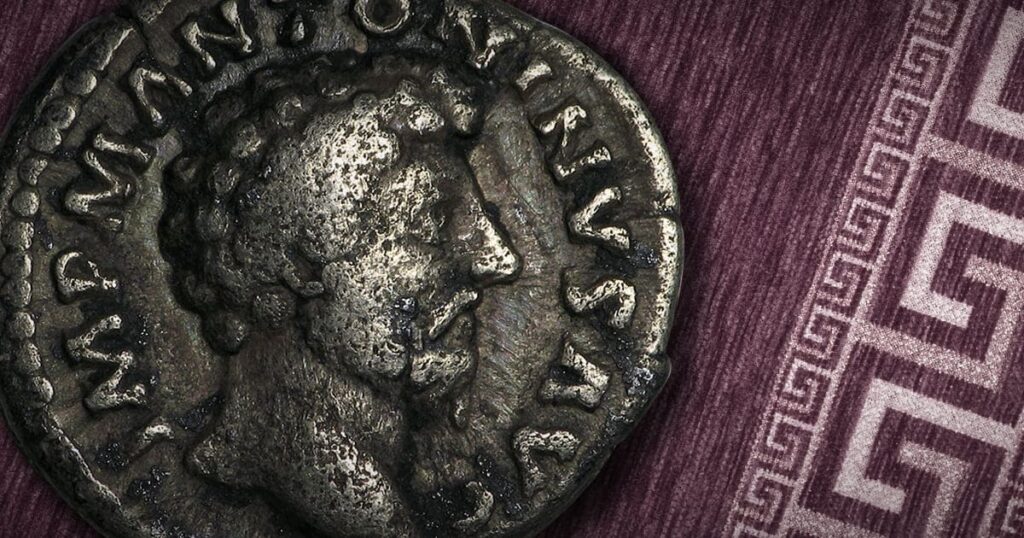
Buying Roman Coins
Now that you know a bit more about Ancient Rome and its coinage, you might be interested in starting or adding to your collection. There are many different reasons why someone might want to buy or collect Roman coins. For some, it is simply a matter of aesthetics – they enjoy the look of Roman coins and want to add them to their collection. Others might be interested in Roman coins for their historical value and enjoy learning about different empires and civilizations.
Here are a few things to keep in mind when buying Roman coins:
- Authenticity: When purchasing Roman coins, be sure to buy from a reputable source that can guarantee the coin’s authenticity. There are many fake Roman coins in the marketplace, so it’s important to do your research to avoid being scammed.
- Condition: Roman coins can be found in various conditions, from brand new to heavily worn. The coin’s condition will greatly affect its price, so inspect the coin closely before making a purchase. The Numismatic Guaranty Corporation (NGC) is one of the two independent, third-party grading services that authenticate and grade ancient coins of all types, not just Roman ones. Price: Roman coins can be relatively cheap to quite expensive, depending on their age, condition, and rarity. Be sure to shop around for the best price before making a purchase.
Roman coins can be purchased in many different places, including online auctions, coin dealers, and private sellers. It is important to note that not all Roman coins on the market are genuine, making it crucial to do research before making a purchase.
Graded vs Non-Graded Roman Coins
When it comes to Roman coins, there are two main types: graded and non-graded. Graded Roman coins are those that have been professionally evaluated and given a numerical score based on their condition by the Numismatic Guaranty Company (NGC). Non-graded Roman coins have not been professionally evaluated and do not have a numerical score.
A collector might be more interested in purchasing graded Roman coins to expand their collection. However, if someone is simply looking to buy Roman coins as a souvenir or for investment purposes, then non-graded Roman coins might be a better option as they tend to be lower priced.
Collecting Roman Coins
Roman coins make for an impressive and fascinating collection. If someone is interested in Roman coins, an impressive historical collection can be built to a vast array of preferences. When it comes to Roman coins, there are many ways to collect them, including focusing on a certain emperor, time period, or theme. Some collectors focus on the Twelve Caesars, which makes a fantastic collection.
How to Store Roman Coins
With a bit of care, a collection of Roman coins will last for many years, making storage an important aspect to address. The main chemical reaction that can damage or destroy ancient coins is humidity, so they should be stored in a cool and dry place away from direct sunlight. If you happen to live in a more humid environment, silica gel packets can be kept near a collection to help lower the levels of humidity.
It is also recommended that ancient coins are kept separated from each other to avoid scratches and bad reactions from different alloys that could lead to damage. When searching for storage options, it is important to avoid acids and PVC plastic that could damage the coins – all storage must be “archival-safe,” a material that will not chemically react with the metal in the ancient coins.
There are many options for storage, including:
- Coin albums and flip sleeves: The sleeves will hold each coin separately from one another to eliminate scratches and chemical reactions. This is an inexpensive way to isolate and catalog your coins for easy viewing.
- Coin capsules: Coin capsules are good for long-term storage of coins you do not need or want to interact with often. The only downside to coin capsules is if your coin happens to be smaller than the capsule, it could move around quite a bit which is why this option is best for coins you will not access often to eliminate extra movement.
- Coin cases and trays: A case with individual trays to stack inside of it, each tray has separate slots with soft fabric to prevent damage. This option is perfect for easy access and great for presentation.
- Coin cabinet: A custom-designed piece of furniture to fit the size of your collection. This can be a more expensive or time-consuming project but will be perfect for a collector who wishes to display their collection in a unique way.
Cleaning and Handling Roman Coins
Typically, a collector does not want their ancient coins to look new because it risks removing the patina, which is a coating on coins that can be many different colors and is considered part of the coin’s character. Many collectors will not buy an ancient coin that has been stripped of its patina, which can make a coin worth less than a coin still maintaining its unique coloration.
Ancient coins are very vulnerable to physical and chemical damage, which they can be exposed to when being handled or attempting to clean coins. Many collectors will hold their coins with their bare hands; gloves are not as necessary with ancient coins as with more modern coins, but that is up to the personal preference of the collector. While using gloves is not an absolute rule, collectors will still be to use caution and common sense while handling their ancient coins. When handling your coins, wash and dry your hands well beforehand and hold the ancient coin by its edges.
If you are considering cleaning your ancient coin, it is not recommended to clean the coins in any way except for the removal of actual dirt from coins taken from the ground. Any patina, tarnishing, or certain deposits should be left on your coin – ancient coins are special because they should look as ancient and unique as they are.
Roman Coins: A Piece of History for Every Collector
Roman coins are a popular type of coin to collect and can range in value from a few dollars to several thousand dollars, making them a viable option for collectors of all budgets. If you are a beginner at collecting or already an experienced collector, Roman coins can be a fun and rewarding hobby for all collectors. With a bit of care, these coins can last for many years, making them both great conversation pieces and investments for the future.

